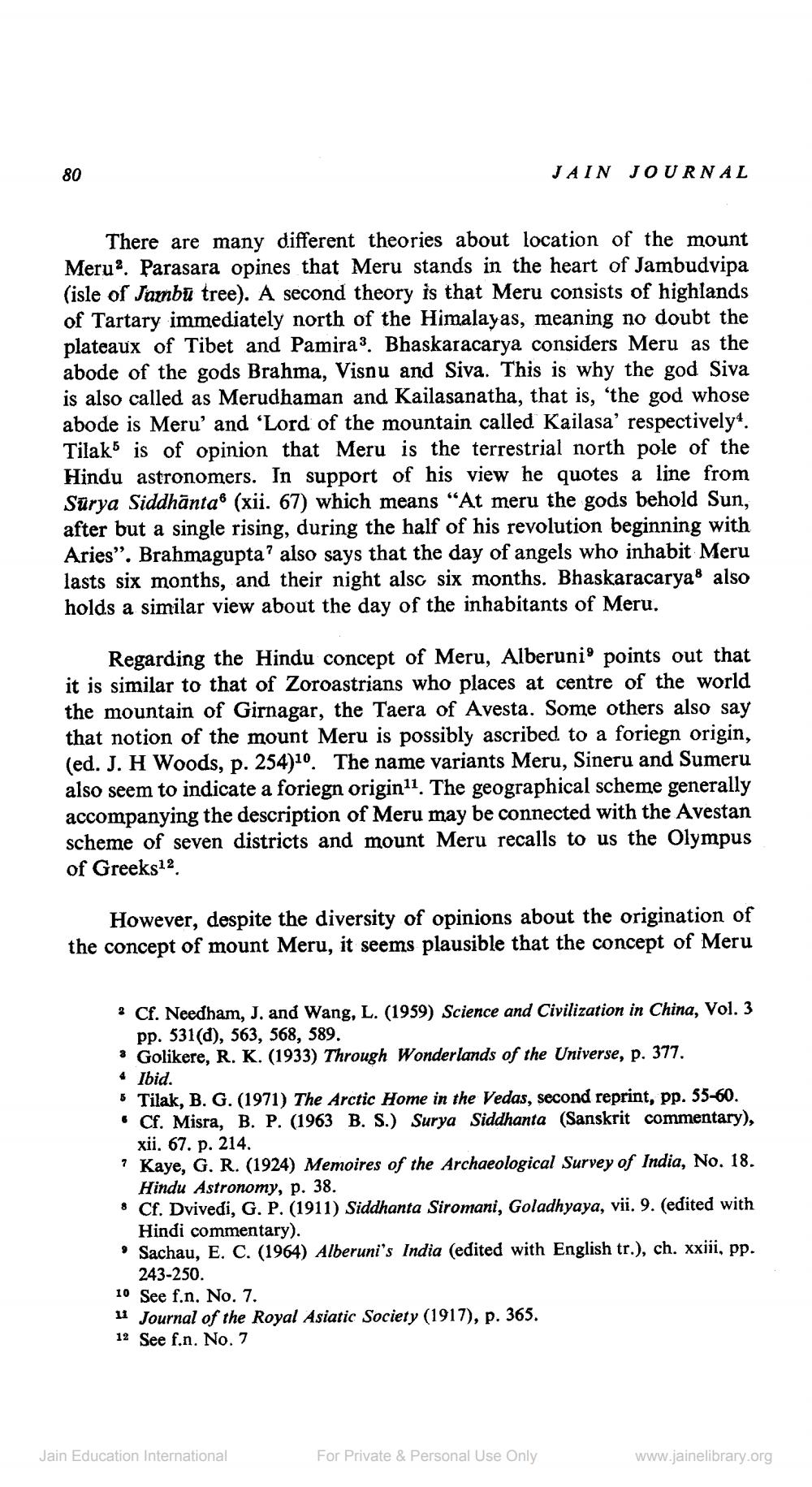Book Title: Jain Journal 1978 01 Author(s): Jain Bhawan Publication Publisher: Jain Bhawan Publication View full book textPage 4
________________ 80 JAIN JOURNAL There are many different theories about location of the mount Merua. Parasara opines that Meru stands in the heart of Jambudvipa (isle of Jambu tree). A second theory is that Meru consists of highlands of Tartary immediately north of the Himalayas, meaning no doubt the plateaux of Tibet and Pamira. Bhaskaracarya considers Meru as the abode of the gods Brahma, Visnu and Siva. This is why the god Siva is also called as Merudhaman and Kailasanatha, that is, 'the god whose abode is Meru' and 'Lord of the mountain called Kailasa' respectively4. Tilak is of opinion that Meru is the terrestrial north pole of the Hindu astronomers. In support of his view he quotes a line from Sürya Siddhānta® (xii. 67) which means "At meru the gods behold Sun, after but a single rising, during the half of his revolution beginning with Aries”. Brahmagupta? also says that the day of angels who inhabit Meru lasts six months, and their night also six months. Bhaskaracaryas also holds a similar view about the day of the inhabitants of Meru. Regarding the Hindu concept of Meru, Alberuni' points out that it is similar to that of Zoroastrians who places at centre of the world the mountain of Girnagar, the Taera of Avesta. Some others also say that notion of the mount Meru is possibly ascribed to a foriegn origin, (ed. J. H Woods, p. 254)10. The name variants Meru, Sineru and Sumeru also seem to indicate a foriegn origin"1. The geographical scheme generally accompanying the description of Meru may be connected with the Avestan scheme of seven districts and mount Meru recalls to us the Olympus of Greeks12 However, despite the diversity of opinions about the origination of the concept of mount Meru, it seems plausible that the concept of Meru ? Cf. Needham, J. and Wang, L. (1959) Science and Civilization in China, Vol. 3 pp. 531(d), 563, 568, 589. * Golikere, R. K. (1933) Through Wonderlands of the Universe, p. 377. 4 Ibid. 5 Tilak, B. G. (1971) The Arctic Home in the Vedas, second reprint, pp. 55-60. • Cf. Misra, B. P. (1963 B. S.) Surya Siddhanta (Sanskrit commentary), xii. 67. p. 214. ? Kaye, G. R. (1924) Memoires of the Archaeological Survey of India, No. 18. Hindu Astronomy, p. 38. . Cf. Dvivedi, G. P. (1911) Siddhanta Siromani, Goladhyaya, vii. 9. (edited with Hindi commentary). • Sachau, E. C. (1964) Alberuni's India (edited with English tr.), ch. xxiii, pp. 243-250. 10 See f.n. No. 7. 11 Journal of the Royal Asiatic Society (1917), p. 365. 12 See f.n. No. 7 Jain Education International For Private & Personal Use Only www.jainelibrary.orgPage Navigation
1 2 3 4 5 6 7 8 9 10 11 12 13 14 15 16 17 18 19 20 21 22 23 24 25 26 27 28 29 30 31 32 33 34 35 36
